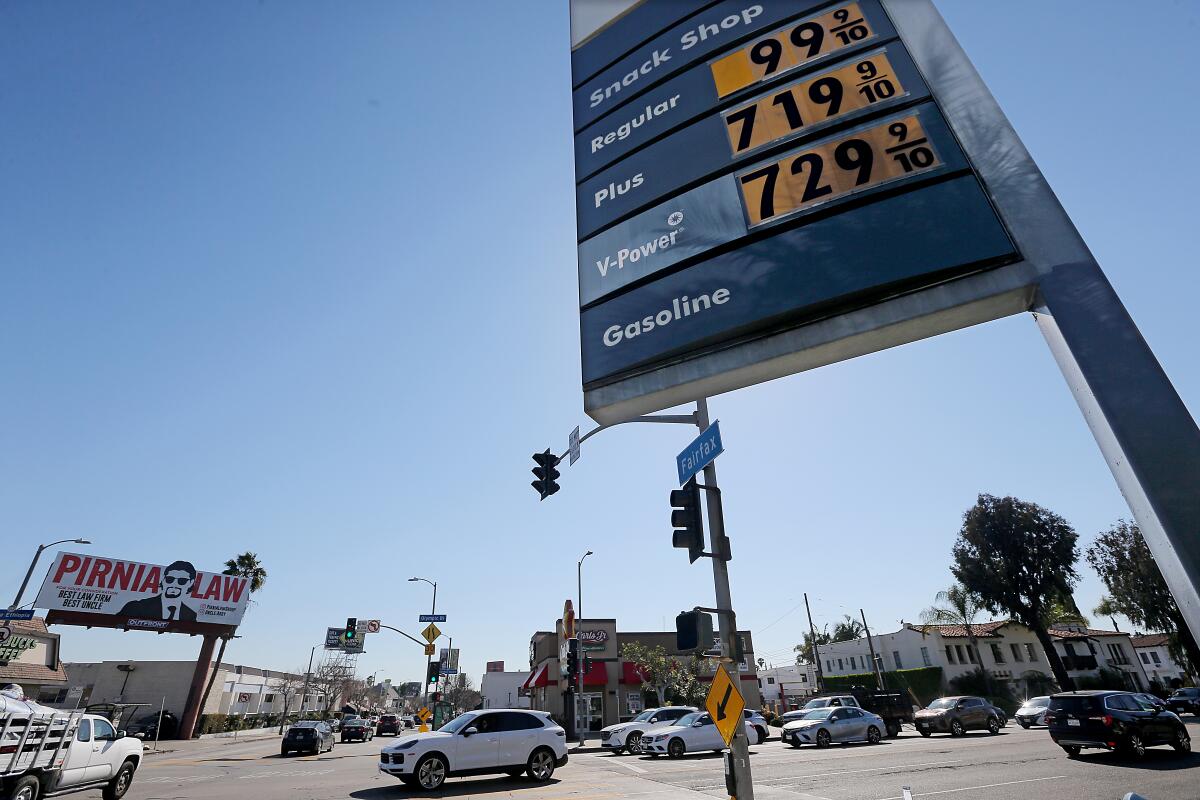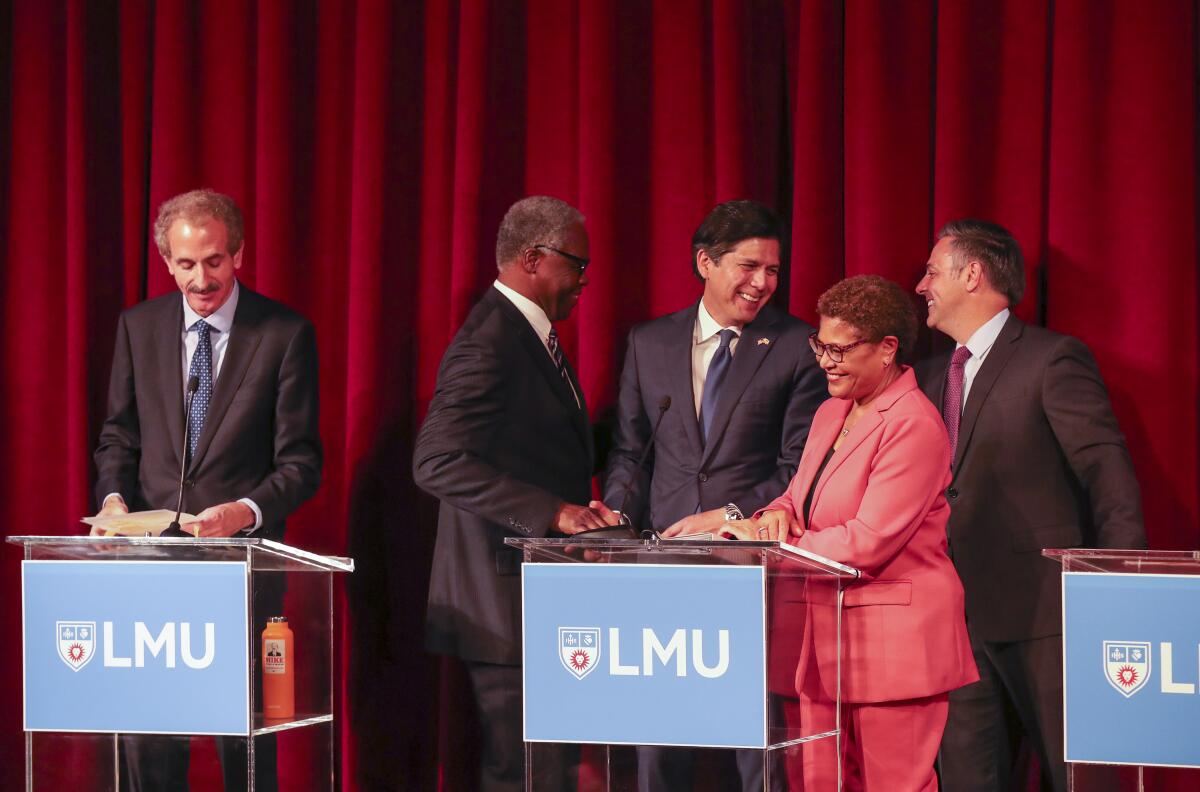This could be the moment to free the U.S. from Russia, Saudi Arabia and all oil barons

- Share via
This is the March 10, 2022, edition of Boiling Point, a weekly newsletter about climate change and the environment in California and the American West. Sign up here to get it in your inbox.
I got a text from a friend the other night: “Is energy about to be the No. 1 domestic hot-button issue for the next couple months?”
My response: “Oy, I hope not. My editors would want me to write stuff constantly!”
Jokes aside — energy should be a hot-button even when gas prices aren’t going through the roof, because energy is climate, and climate is everything. But crisis creates opportunity. And right now, there’s intense global interest in energy supplies.
So with Russia waging war against Ukraine, I wrote about why it’s time to get serious on climate. By accelerating the shift to electric cars and electric heat pumps, the U.S. and Europe could slash emissions while dealing a powerful blow to Vladimir Putin, whose military strength is funded by oil and natural gas. If there were ever a moment for America to break through its political logjam on climate and start taking dramatic steps to phase out fossil fuels, this might be it, experts told me.
Michael Wara, a Stanford University energy professor, proposed a trade: The U.S. should increase oil and natural gas production in the short term to combat Putin and limit gas prices, but only if Congress approves “a massive program to electrify the U.S. vehicle fleet.” The clean energy provisions in Biden’s stalled “Build Back Better” legislation could offer a starting point, Wara said.
“It’s a short-term win for the oil industry and the shale patch, and it’s a long-term win for all Americans that this will never happen again,” he said. “We won’t be vulnerable to some madman somewhere who happens to have a bunch of oil in the ground.”
“And it’s not going to be the last time,” he added. “[Mohammed] bin Salman, Saudi Arabia is a time bomb. If Russia is problematic, just imagine if there was a problem on the Arabian Peninsula, in the kingdom. What would happen? We’re so vulnerable.”
Why is the American economy so vulnerable, when the U.S. is the world’s largest oil producer and Russia accounts for a tiny percentage of imports? My colleagues Don Lee and Samantha Masunaga tackle that question, while Lila Seidman explores how high gas prices might get. (Short version: “It’s all dependent on Putin.”) My editor Nancy Rivera Brooks, meanwhile, wrote about a fun fact you may not have known: Oil refineries in California and Washington state are Russia’s biggest U.S. customers.

If you’re looking to find (relatively) cheap gas, we’ve got a guide for you. And if you’re wondering what the hell’s going on with the handful of Los Angeles-area gas stations charging an exorbitant $7 a gallon, The Times’ Sam Dean talked with the owner of one of those stations, across the street from the Beverly Center. It turns out plenty of people are willing to pay the upcharge.
It’s worth keeping in mind that gas prices have been higher in the past when accounting for inflation, as columnist Michael Hiltzik notes. But the economic pain is real — unless you’re an oil company, in which case you might be raking in enormous profits.
“Multinational oil companies have been exploiting the run-up in the price of crude to line their pockets,” Hiltzik writes. “Chevron’s shares have risen more than 40% and ExxonMobil’s about 35% this year. Those are profits you’re feeding at the pump.”
Nobody likes paying high gas prices — wow, that’s an understatement — but my colleague Jaimie Ding reported on a new poll released Monday that found 71% of Americans would support a ban on Russian oil imports, even if it meant higher prices.
The very next day, Biden announced such a ban, declaring, “We will not be part of subsidizing Putin’s war.”
Polling aside, politicians know voters are prone to punish them for pain at the pump. That’s why Newsom proposed a tax rebate to offset high gas prices during his State of the State address, as reported by The Times’ Taryn Luna and Phil Willon.
It’s also why the Biden administration is considering easing sanctions on Venezuela to access the country’s oil reserves, and why administration officials have tried (without success) to get Saudi Arabia and the United Arab Emirates to produce more oil.
But at least so far, Biden has resisted calls from the fossil fuel industry and Republican lawmakers to lease more federal land for oil and gas drilling. The president pointed out that companies are already sitting on thousands of drilling permits.
As far as former California Gov. Jerry Brown is concerned, that’s the right decision.
“It’s true that the Russians are earning money from oil and gas, but to compound that problem by accelerating oil and gas in America would go against the climate goals, and climate is like war: If we don’t handle it, people are going to die and they’re going to be suffering. Not immediately, but over time,” Brown told the AP’s Kathleen Ronayne at his off-grid ranch in Colusa County.
Santa Barbara County supervisors also decided this week not to increase oil production, voting 3-2 to stop ExxonMobil from restarting three offshore wells that have been shut down since a 2015 spill. State officials took a gradual step to lessen California’s petroleum addiction, too, proposing that 68% of cars sold in the state should be electric or otherwise zero-emission by 2030.

But it was the Biden administration that made the biggest move this week to help California ditch oil. Federal officials restored the state’s authority to set its own pollution rules for cars and trucks — an authority President Trump had revoked
“It’s not only vital to California, but to the entire country,” Environmental Protection Agency chief Michael Regan told my colleague Russ Mitchell, who wrote about EPA’s decision. “We will work very closely with the state of California, with automakers, with the union, and the environmental stakeholders to make sure all of us are rolling together toward a clean vehicle future.”
EPA also proposed new rules this week to crack down on smog-forming pollution from tractor-trailer trucks, buses and other heavy-duty vehicles, per The Times’ Alex Wigglesworth, Anumita Kaur and Thomas Curwen. It’s another move that could reduce America’s dependence on oil, while also limiting toxic fumes that are especially harmful to low-income communities of color.
So what comes next? The eyes of the nation might once again turn to West Virginia Sen. Joe Manchin III, a Democrat who got rich off fossil fuels and for months has joined with his Republican colleagues to block Biden’s Build Back Better legislation.
Manchin has suggested he’s open to the bill’s $555 billion in climate and clean energy investments. But he also told Politico he wants to see a deal that increases coal, oil and natural gas production, especially considering Russia’s war on Ukraine.
If the White House can’t or won’t agree to Manchin’s demands, there’s more Biden could do on his own. For instance, the Washington Post reports that officials have discussed using the Defense Production Act to scale up production of electric heat pumps for export to Europe — a move that could undermine the fossil fuel wealth funding Putin’s military aggression. (For more on the geopolitical implications of the Russian petrostate, see this in-depth piece by Marianne Lavelle for Inside Climate News.)
Whatever happens next, hopefully it happens fast — not only because Ukrainians are dying and suffering, but because the longer this crisis lasts, the more unpredictable the climate and energy implications. The Times’ Susanne Rust, for instance, reports that U.S. and Russian scientists who had been working together on Arctic research have cut off communication since the invasion of Ukraine — just one sign of how Russian aggression could derail, rather than accelerate, the fight against climate change.
I also don’t want to think too hard about Ukraine’s Chernobyl nuclear site, because the situation does not sound great.
So will energy be the No.1 hot-button issue for the next couple months? Yes, it very well might be — and if not, it should.
On that note, here’s what’s happening around the West:
TOP STORIES

Three leading candidates for Los Angeles mayor — Karen Bass, Rick Caruso and Kevin de León — don’t currently mention climate change on their campaign websites. That’s according to the latest edition of our L.A. on the Record election-season newsletter, written by Dakota Smith, Benjamin Oreskes and David Zahniser. Maybe those candidates ought to read the recent United Nations climate science report (or sign up for this newsletter). If they don’t have time for the full U.N. report, my colleague Ian James has five key takeaways, including the importance of safeguarding natural ecosystems that absorb and store carbon.
Researchers have found the fingerprints of climate change in the 2017 near-disaster at California’s Oroville Dam. The atmospheric river rainfall that nearly broke the dam — and prompted evacuation orders for nearly 200,000 people — was made 11% to 15% worse by global warming, Thomas Fudge reports for KPBS. It’s a reminder that floods and droughts alike “are being dangerously distorted and exaggerated by the carnival mirror of climate change,” as my colleague Paul Duginski writes. It’s also a reminder that cities could bulwark themselves against drought by capturing more water when it does rain. But so far, L.A. County has been slow to spend newly approved tax dollars on stormwater capture projects, The Times’ Ralph Vartabedian reports.
A new study shows how air pollution is worse today in formerly redlined communities, half a century after the racist housing practice was outlawed. L.A.’s Boyle Heights neighborhood is Exhibit A, the Washington Post’s Darryl Fears reports. Several freeways were built through the neighborhood — not far from where another highway, the 110, was built alongside the Arroyo Seco, a tributary of the Los Angeles River. I mention this because I recently learned from my colleague Patt Morrison that when then-President Theodore Roosevelt visited the city a century ago, he fell in love with the waterway’s natural beauty, advising us never to change it: “This arroyo would make one of the greatest parks in the world.” The 110 freeway changed all that.
POLLUTION AND POLITICS

When noxious odors spewed from Dominguez Channel after a warehouse fire last fall, it was only the latest environmental indignity for Los Angeles County residents living near the flood control channel. My colleague Louis Sahagún wrote about the heavy pollution along the waterway that politicians have long ignored, including emissions from oil refineries. In other news, L.A. is suing Monsanto and two other companies for PCB contamination in local waterways, the AP’s John Antczak reports. A few hours south, near the U.S.-Mexico border, Imperial Beach doesn’t want sewage washing in from Tijuana every time it rains — but that stormwater runoff may help sustain wetland ecosystems, Joshua Emerson Smith reports for the San Diego Union-Tribune.
The California bullet train has its first legal challenge in the Los Angeles area — and yes, it’s a CEQA lawsuit. That would be the California Environmental Quality Act, and it’s being wielded by Hollywood Burbank Airport, which says the high-speed rail project’s desired route could affect its operations and safety, as Ralph Vartabedian reports for The Times. Regardless of whether the lawsuit has merit, it’s pretty ironic from a climate perspective to see an airport trying to use an environmental law to slow a rail project, since the two would be in direct competition and airplanes emit far more planet-warming pollution than trains.
The Natural Resources Defense Council has played a fraught role in California’s debate over rooftop solar incentives. It’s the one major environmental group aligned with the monopoly utility companies in their desire to slash incentives, as Dan Gearino and Anna Marshall-Chalmers write in a thoughtful story for Inside Climate News examining NRDC’s position. See also my story from November outlining how rooftop solar got so controversial, and my latest coverage of what state officials are considering.
THE ENERGY TRANSITION
Pacific Gas & Electric and General Motors launched a fascinating project to test the use of GM electric vehicle batteries to keep homes powered during blackouts. Here’s the story from Canary Media’s Jeff St. John on the two companies’ efforts and the promise of “vehicle-to-home” technology. In the meantime, PG&E is trying to limit the need for blackouts by trimming trees along power lines that might spark fires — but not without criticism. The company is in trouble with Cal Fire for using a massive “heli-saw” — whirring blades suspended from a helicopter — to trim some trees without permission, The Times’ Lila Seidman reports.
The world’s largest battery storage facility, at Moss Landing along the Central California coast, is still offline after two overheating incidents. But PG&E and battery owner Vistra Corp. are moving forward with plans to double its capacity with 350 megawatts of new lithium-ion storage, Christopher Neely writes for Monterey County Weekly. About 100 miles south, another company hopes to build a compressed air energy storage facility near Morro Bay — but state officials have halted exploratory drilling, saying the company hasn’t complied with the Coastal Act, Mackenzie Shuman writes for the San Luis Obispo Tribune.
NorthWestern Energy is the latest electric utility to pledge net-zero emissions by 2050. But the company still plans to build new gas-fired power plants in Montana and South Dakota, Tom Lutey reports for the Billings Gazette. Maybe carbon capture will help down the road, although the technology is still expensive and relatively limited, per Nicholas Kusnetz at Inside Climate News.
AROUND THE WEST
Federal endangered species protections have been no panacea for the San Bernardino kangaroo rat, which has lost 95% of its historic desert habitat to development since 1998. California just listed the rat as endangered, too — but it’s far from clear if that will prevent extinction, in part because conservationists say there are too many loopholes for developers. The New York Times, meanwhile, has a new map showing California has the most imperiled biodiversity of any state in the contiguous U.S.
Nevada’s Clark County — home to Las Vegas — generated more planet-warming emissions than the city of Los Angeles in 2019, per its own accounting. That’s according to this eye-opening story by Gabrielle Canon for the Guardian, examining how Sin City might cope with record heat, record drought and record population growth. Elsewhere in the Southwest, a team of journalists from Arizona State University’s Walter Cronkite School reported on New Mexico Gov. Michelle Lujan Grisham’s efforts to cut down on planet-warming emissions while also sustaining the state’s lucrative oil and gas industry — a tricky balance, to say the least.
There’s a long history of Native American tribes being excluded from Colorado River decision-making, from the 1922 deal that divided up the river’s waters to the 2007 “interim guidelines” that apply today. But tribes hold a right to one-quarter of the Colorado, and they’re fighting harder than ever to claim what’s theirs, Pauly Denetclaw reports for High Country News.
ONE MORE THING

I finally went out to a movie theater this weekend and saw Paul Thomas Anderson’s “Licorice Pizza,” a weird and nostalgic film taking place in the San Fernando Valley in the 1970s. As a born-and-raised Angeleno who has spent a lot of time in the Valley, I enjoyed the film and appreciated the local history — including a subplot centered around the Arab oil embargo of 1973.
Watching Southern Californians wait in long lines for gasoline amid shortage fears felt strangely relevant today, with gas prices rising rapidly and the U.S. government urging other countries to increase supplies. But it’s worth remembering that the energy situation was a lot worse a half-century ago. Today, at least, you can fill your tank without much trouble — or go electric.
We’ll be back in your inbox next week. If you enjoyed this newsletter, please consider forwarding it to your friends and colleagues.






